This is a summary of the Healthy Food and Drink in NSW Health Facilities for Staff and Visitors Framework. It has been designed for use by vendors.
To check or confirm any details, please refer to the Toolkit.
Additional resources are also available including:
- Frequently Asked Questions
- Individual tools from the Toolkit
- Healthy Catering Guidelines
- Promotional resources
Support and contacts
- Healthy Food Information Service (HFIS) on 1800 930 966 or healthyfood@health.nsw.gov.au.
- Health Promotion Service, Illawarra Shoalhaven Local Health District (ISLHD) on 4221 6728 or ISLHD-HealthPromotion@health.nsw.gov.au
Aims of the Framework
The Healthy Food and Drink in NSW Health Facilities Framework aims to:
- Promote and increase the availability of healthy food and drink options
- Decrease the availability of unhealthy food and drink options
- Support water as the best beverage choice.
Product availability
- Sugary drinks are not sold.
- EVERYDAY food and drinks make up 75% or more of the total food and drinks.
- OCCASIONAL food and drinks make up no more than 25% of the total foods and drinks.
Product quality
- A HEALTH STAR RATING OF 3.5 or more stars applies to some EVERYDAY and OCCASIONAL foods and drinks.
Product size
- Portion size limits apply to SOME EVERYDAY food and drinks.
- Portion size limits apply to ALL OCCASIONAL food and drinks.
Product position
- Only EVERYDAY food and drinks are at eye level or included in promotions and deals.
Packaged drinks
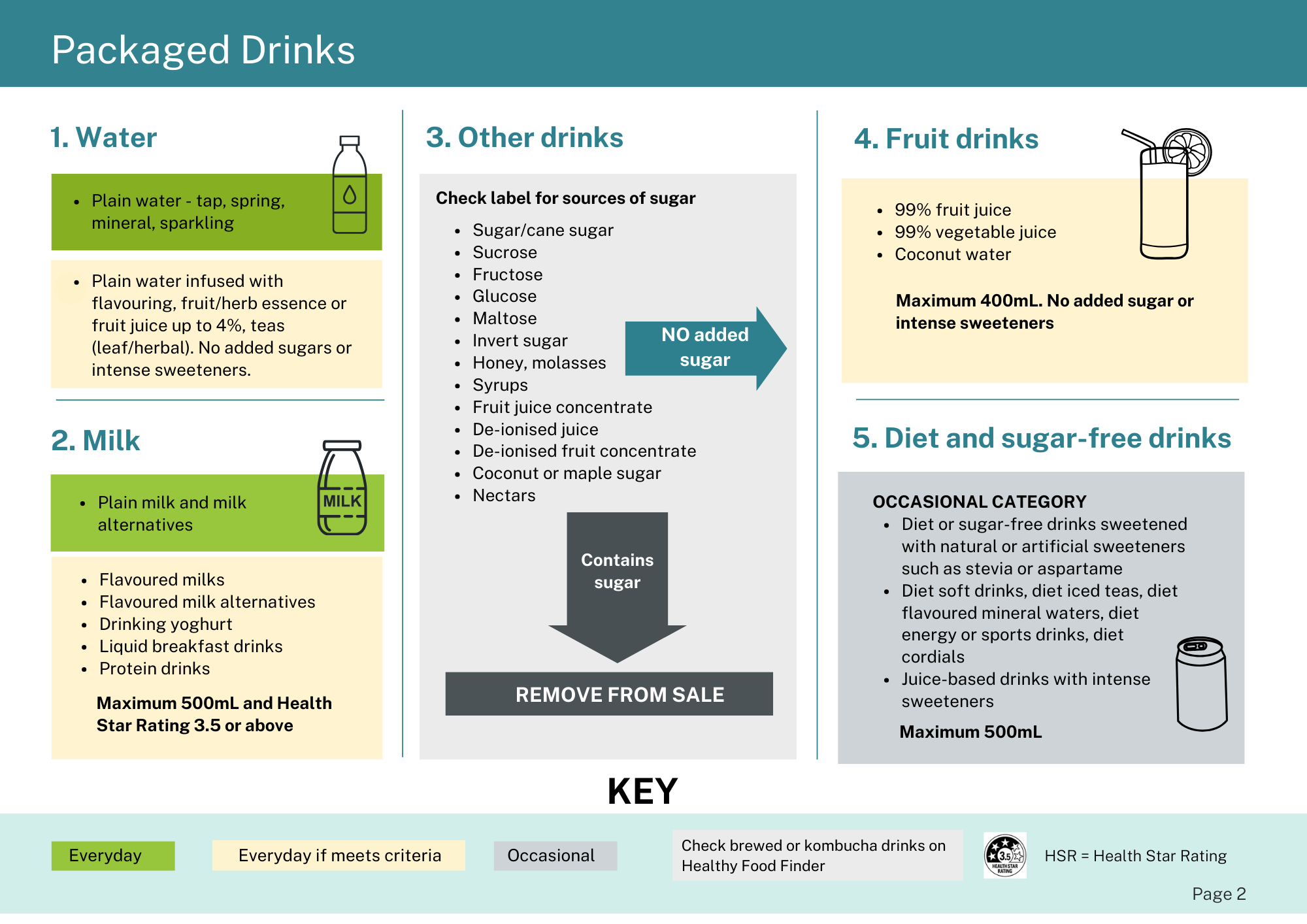
Everyday and Occasional Foods and Drinks

What are everyday and occasional foods and drinks?
- EVERYDAY FOODS make up at least 75% of available items. They are meals, snacks and drinks made from foods in the five food groups. For example, sandwiches, soups, pasta dishes, yoghurt and fruit.
- OCCASIONAL FOODS make up no more than 25% of available items. These are foods high in saturated fats, sugars and/or salt and usually have little nutritional value. For example, pies, chips, sweet muffins and confectionery.
- ANY PRODUCTS THAT INCLUDE OCCASIONAL INGREDIENTS ARE CLASSED AS OCCASIONAL e.g. Salad sandwich with salami is occasional.
Everyday and Occasional foods are listed in the sections below. Health Star Rating may be written as HSR.
Vegetables and legumes
Everyday options
- Vegetables - all varieties of vegetables and legumes. Fresh, frozen and canned. Preferably reduced salt or no added salt.
- Legumes - includes lentils and beans such as kidney beans, chickpeas and baked beans. Fresh, dried, frozen and canned. Preferably reduced salt or no added salt.
- Unsalted legume snacks - roasted chickpeas, wasabi peas and other legume snacks. Freshly prepared - do not add salt. Packaged varieties - Health Star Rating 3.5 or above preferred.
- Lightly salted legume snacks - No confectionery. Freshly prepared - 50g portion limit. Packaged varieties 50g portion limit and Health Star Rating 3.5 or above.
- Dips - Freshly made using EVERYDAY foods - vegetable-based - hummus, tzatziki, beetroot, eggplant, avocado, salsa. Packaged varieties preferably HSR 3.5 or above. For cream-cheese or sour-cream based dips - check on the Healthy Food Finder online database.
Occasional options
- Hot potato chips, wedges, potato gems, hash browns, scallops. 100g portion limit. Packaged varieties also HSR 3.5 or above.
- Salty snacks - coated nuts, soy crisps, grain crisps. 50g portion limit and HSR 3.5 or above.
Fruit
Everyday options
- Fruit - fresh, frozen, canned in juice (not syrup) and drained before serving.
- Dried fruit - plain dried fruit - no chocolate or yoghurt coatings. 50g portion limit.
- Dried fruit and nut mixes - 50g portion limit. Packaged varieties 50g portion limit and Health Star Rating 3.5 or above.
Occasional options
- Dried fruit with chocolate, yoghurt coating or confectionery. 50g portion limit.
Grains and cereals
Everyday options
- Cereals and grains - Rice, pasta, noodles, polenta, couscous, oats, quinoa, barley. Preferably wholegrain or high fibre varieties.
- Bread/toast - all types - wholemeal, multigrain, white, rye, Turkish, Lebanese, lavosh, focaccia, pita, tortillas, wraps, rolls, bagels, English muffins, crumpets, un-iced fruit bread and buns. Includes gluten-free varieties.
- Breakfast cereals - no sugary types, no added confectionery, preferably wholegrain. Flakes, bran, muesli, porridge. Packaged varieties with Health Star Rating 3.5 or above.
- Savoury biscuits/crackers/crispbread - unflavoured/plain crackers, rice crackers, rice cakes, cracker thins, wafer thins, breadsticks and crispbread. Preferably wholegrain or high fibre varieties. Health Star Rating 3.5 or above.
- Scones, pikelets, pancakes - plain, fruit, vegetable varieties. Packaged varieties preferably HSR 3.5 or above.
- Pastry - puff, shortcrust, filo - only if Health Star Rating 3.5 or above.
- Muesli and snack bars - cereal-based bars; fresh or dried fruit-based bars; nut, protein and breakfast bars. No added confectionery or yoghurt. 50g portion limit and HSR 3.5 or above.
- Unsalted popcorn - plain air-popped popcorn. Freshly prepared - do not add salt. Packaged varieties - Health Star Rating 3.5 or above preferred.
- Lightly salted and flavoured popcorn - no confectionery. Freshly prepared on site - 50g portion limit. Packaged varieties 50g portion limit and Health Star Rating 3.5 or above.
Occasional options
- Iced buns - 80g portion limit.
- Garlic and cheese/bacon breads - 90g portion limit. If packaged, also HSR 3.5 or above.
- Instant flavoured noodles - 75g portion limit (dried). If packaged, also HSR 3.5 or above.
- Corn chips, hard taco shells - 50g portion limit. If packaged also HSR 3.5 or above. Preferably plain, unsalted varieties.
- Flavoured savoury biscuits /crackers crispbread - 50g portion limit and HSR 3.5 or above.
- Salted and flavoured popcorn with confectionery and/or coatings - 50g portion limit and HSR 3.5 or above.
- Cakes, slices, sweet biscuits and pastries - preferably un-iced. Includes banana bread. Various portion limits.
- Muesli bars containing confectionery, yoghurt or chocolate - 50g portion limit.
Dairy foods
Everyday options
- Milk - Plain milk & alternatives (soy, rice, nut milks fortified with calcium) - fresh or UHT. Preferably reduced fat.
- Flavoured milk - Includes milk alternatives and coffee-flavoured milks. Preferably reduced fat. 500ml portion limit. Packaged varieties also HSR 3.5 or above.
- Cheese - E.g. Colby, cheddar, tasty. Preferably reduced fat. Includes cheese packaged with plain crackers. Packaged varieties preferably HSR 3.5 or above.
- Yoghurt - Greek, natural, plain, soy, flavoured. No added confectionery. Preferably reduced fat and HSR 3.5 or above. No coconut-milk-based yoghurt.
- Custard - prepared on site with reduced-fat milk. Packaged - must have Health Star Rating 3.5 or above.
- Dips - Freshly made using EVERYDAY foods - hummus, tzatziki, beetroot, eggplant, avocado, salsa. Packaged varieties preferably HSR 3.5 or above. For cream-cheese or sour-cream based dips - check on the Healthy Food Finder online database.
Occasional options
- Custard or yoghurt with confectionery. 100g portion limit. Coconut-milk-based products.
- Desserts.
Meat and alternatives
Everyday options
- Meat, poultry - lean meat, trim fat and skin, includes ham.
- Canned chicken, preferably HSR 3.5 or above.
- Eggs - boiled, poached, scrambled, omelettes.
- Fish - Canned tuna - plain, in springwater, including those with plain crackers/ salads/ beans/ pasta. Preferably HSR 3.5 or above.
- Unsalted nuts and seeds - may be roasted. Freshly prepared - do not add salt. Packaged varieties - Health Star Rating 3.5 or above are preferred. Includes dried fruit and nut mixes.
- Lightly salted nuts and seeds - No confectionery. Freshly prepared - 50g portion limit. Packaged varieties 50g portion limit and Health Star Rating 3.5 or above. Includes dried fruit and nut mixes.
Occasional options
- Processed meats - bacon, chorizo, prosciutto, salami, sausage, processed chicken roll. 60g portion limit.
- Crumbed or coated products - schnitzel, crumbed or battered fish, fried products. 140g portion limit.
- Salted nuts and seeds including those with sweet coatings (chocolate, yoghurt, sugar) or confectionery. 50g portion limit and HSR 3.5 or above.
Common occasional foods
ANY PRODUCTS THAT INCLUDE OCCASIONAL INGREDIENTS ARE CLASSED AS OCCASIONAL e.g. Caesar salad with bacon is OCCASIONAL.
Savoury products
- Fried products
- Pies
- Sausage rolls and savoury pastries - includes spring rolls, samosas, quiche, filled pastries, ricotta and spinach triangles
- Croissants
- Corn chips
- Taco shells
- Processed meats (except for ham)
- bacon
- chorizo
- prosciutto
- salami
- sausage
- corned beef
- processed chicken roll
- Crumbed, battered or similar coatings
- schnitzel
- crumbed or battered fish
- Garlic and cheesy breads
- Hot potato chips, wedges, gems, scallops or hash browns
- Instant flavoured noodles
- Salted snacks.
Sweet products
- Sweet pastries
- Croissants
- Danishes
- Sweet biscuits
- Cakes and muffins
- Banana bread
- Slices
- Desserts
- Confectionery
- Ice-cream
- Frozen yoghurt
- Ice-blocks
- Milk drinks with added ice-cream or sorbet.
75% everyday benchmark - chilled food display
What to calculate
Chilled food display units are defined as:
- A refrigerated cabinet or fridge
- All cake cabinets (ambient or chilled).
Each food and drink option is one type
- Ham and cheese sandwich = 1 type
- Cheese sandwich = 1 type
- Cheese and salad sandwich = 1 type
- Strawberry yoghurt = 1 type
- Mango yoghurt = 1 type.
Count each type once only, even if there are multiple rows of the same type.
Count
- The total number of types of food and drinks in the chilled food displays
- The number of types of food and drinks in the chilled food displays that are EVERYDAY.
Calculate
- Number of types of food and drinks in the chilled food displays that are EVERYDAY
- DIVIDE BY Total number of types of food and drinks in the chilled food displays
- MULTIPLY by 100
- ANSWER is % EVERYDAY products.
How to reach 75% benchmark
To calculate the minimum number of EVERYDAY types.
- Count the total number of TYPES of food and drinks
- Multiply number of TYPES by 0.75
- Round up result if needed.
If unsure about any product, use the Healthy Food Finder.
Example

75% everyday benchmark - hot food display
What to calculate
Hot food display units are defined as:
- A heated unit that stocks food e.g. buffets, pie warmers, hot food cabinets
- Only includes hot food display units that are visible to consumers.
Each food option is one type, including different serve sizes
- Packaged large lasagne = 1 type
- Packaged small lasagne = 1 type
- Meat pie = 1 type
- Hot chips = 1 type.
Count each type once only, even if there are multiple examples of the same type.
Count
- The number of types of food and drinks in the hot food displays
- The number of types of food and drinks in the hot food displays that are EVERYDAY.
Calculate
- Number of types of food and drinks in the hot food displays that are EVERYDAY
- DIVIDE BY Total number of types of food and drinks in the hot food displays
- MULTIPLY by 100
- ANSWER is % EVERYDAY products.
How to reach 75% benchmark
To calculate the minimum number of EVERYDAY types.
- Count the total number of TYPES of food and drinks
- Multiply number of TYPES by 0.75
- Round up result if needed.
If unsure about any product, use the Healthy Food Finder.
Example
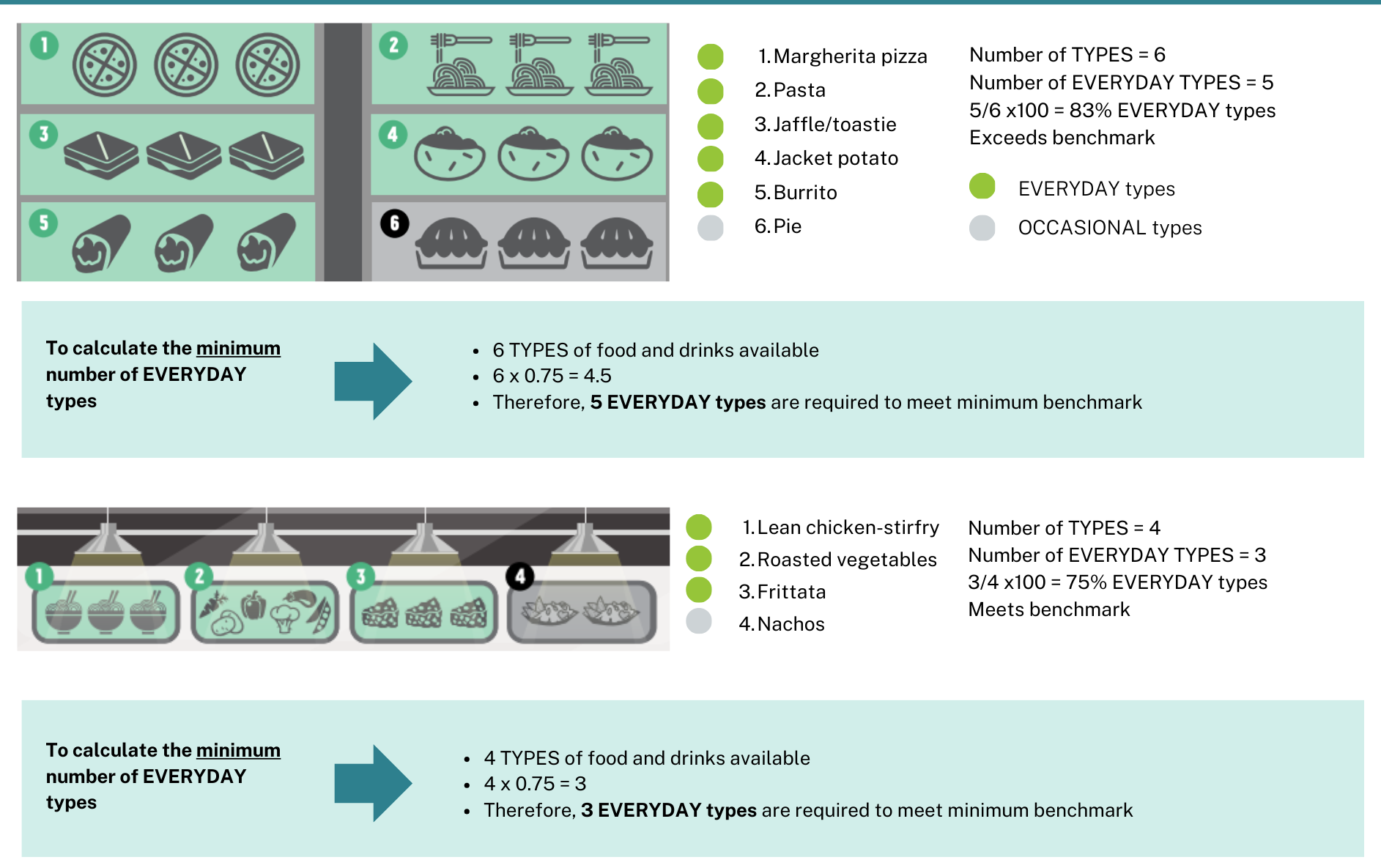
75% everyday benchmark - vending machines
What to calculate
What is a facing?
- In a clear front vending machine, each slot that is occupied and visible to the consumer is one facing.
- For covered-front machines, each menu option on the vending machine is one facing.
- Count each facing even if there are multiple facings of the same product.
Count
- The number of facings containing products.
- The number of facings that contain EVERYDAY products.
Calculate
- Number of facings of food and drinks in the vending machine that are EVERYDAY
- DIVIDE BY the number of occupied facings
- MULTIPLY by 100
- ANSWER is % EVERYDAY products.
How to reach 75% benchmark
To calculate the minimum number of EVERYDAY types.
- Count the total number of TYPES of food and drinks
- Multiply number of TYPES by 0.75
- Round up result if needed.
If unsure about any product, use the Healthy Food Finder.
Example - Combination Vending Machine
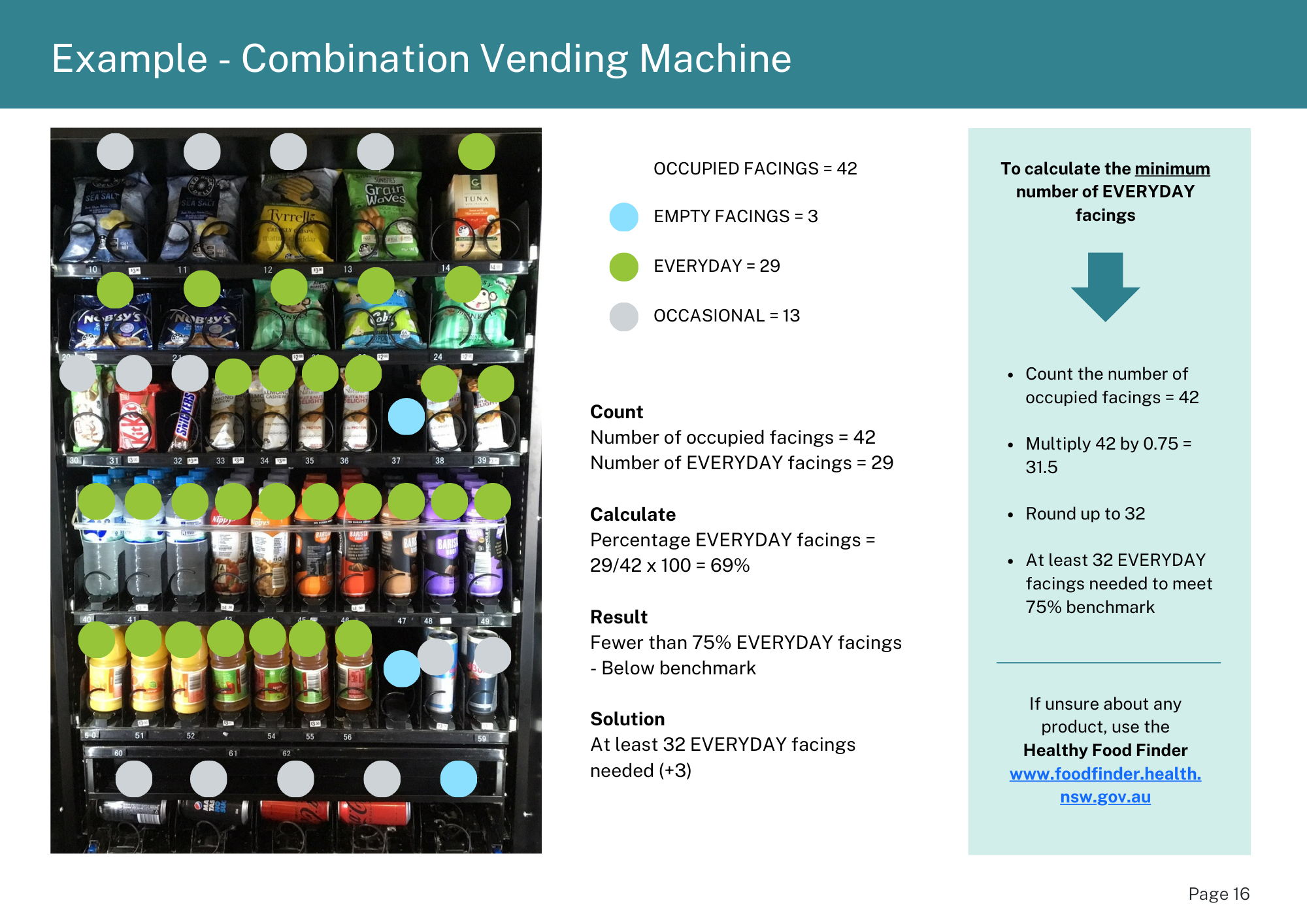
Health Star Rating
The Health Star Rating System is a quick and easy way to compare the nutrient content of similar packaged foods. It considers the overall nutritional content of food and drinks and rates them from 1/2 a star to 5 stars. The more stars, the healthier the choice.
Selected products require a Health Star Rating of 3.5 or higher to meet the criteria of the Framework. Health Star Rating symbols are not mandatory so if a product does not display a rating, check the product on the Healthy Food Finder www.foodfinder.health.nsw.gov.au
Health Star ratings are usually found on the front of the packaging.
Muesli bars
What is a muesli bar?
- Muesli bars include cereal-based bars, fresh or dried fruit-based bars, nut bars, nut balls, bliss balls, protein bars, protein balls, breakfast bars
- Muesli bars are OCCASIONAL products if they contain any confectionery, yoghurt coating, chocolate or carob, sprinkles, icing, lollies, marshmallow, liquorice or sugar-based toppings or fillings such as caramel, coconut ice.
- Muesli bars may contain cocoa, cocoa nibs and cocoa dusting.
To be an EVERYDAY product, muesli bars must have:
- a Health Star Rating of 3.5 stars or more
- a maximum portion size of 50g.
Muesli Bars Flowchart
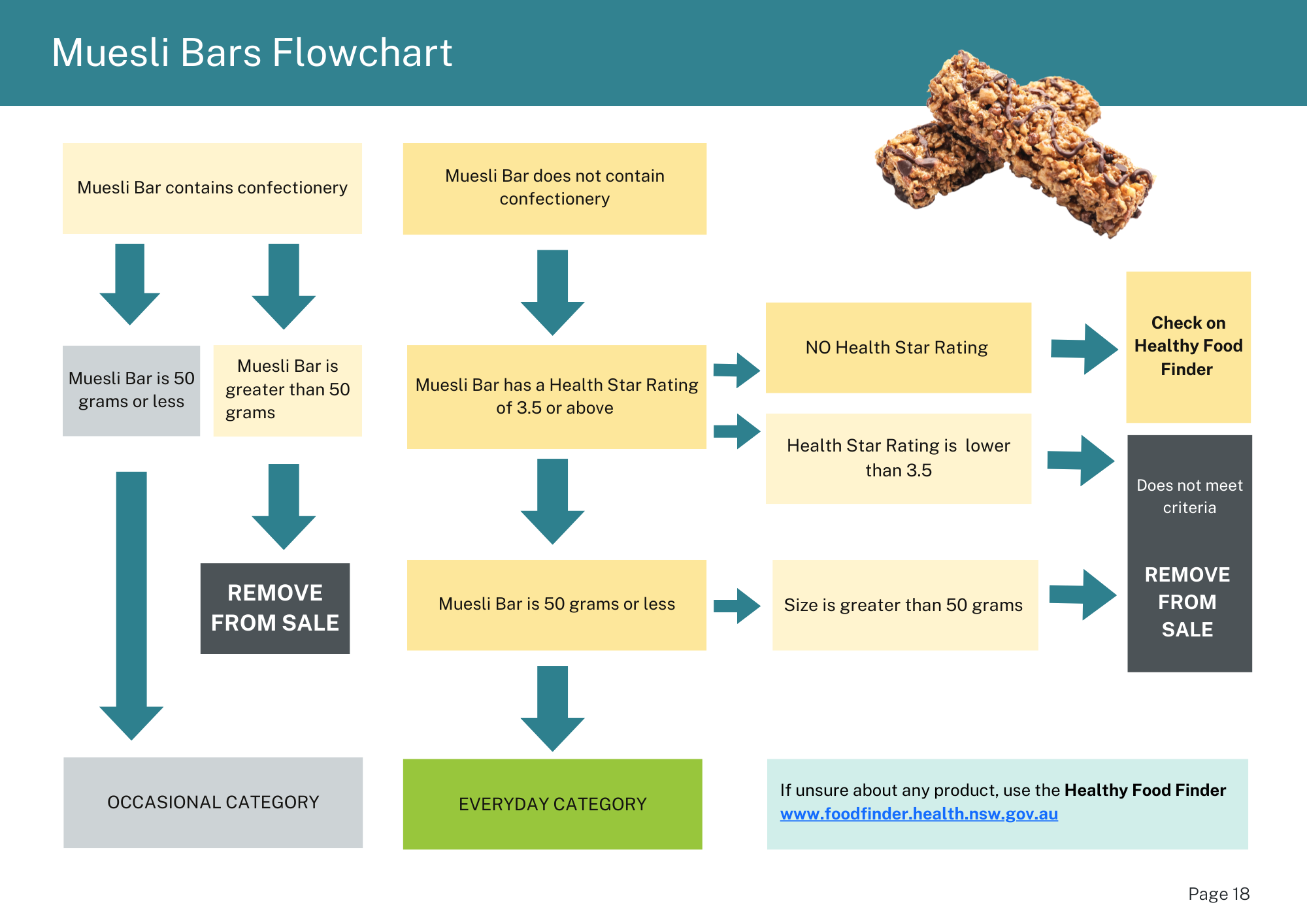
Dried fruit
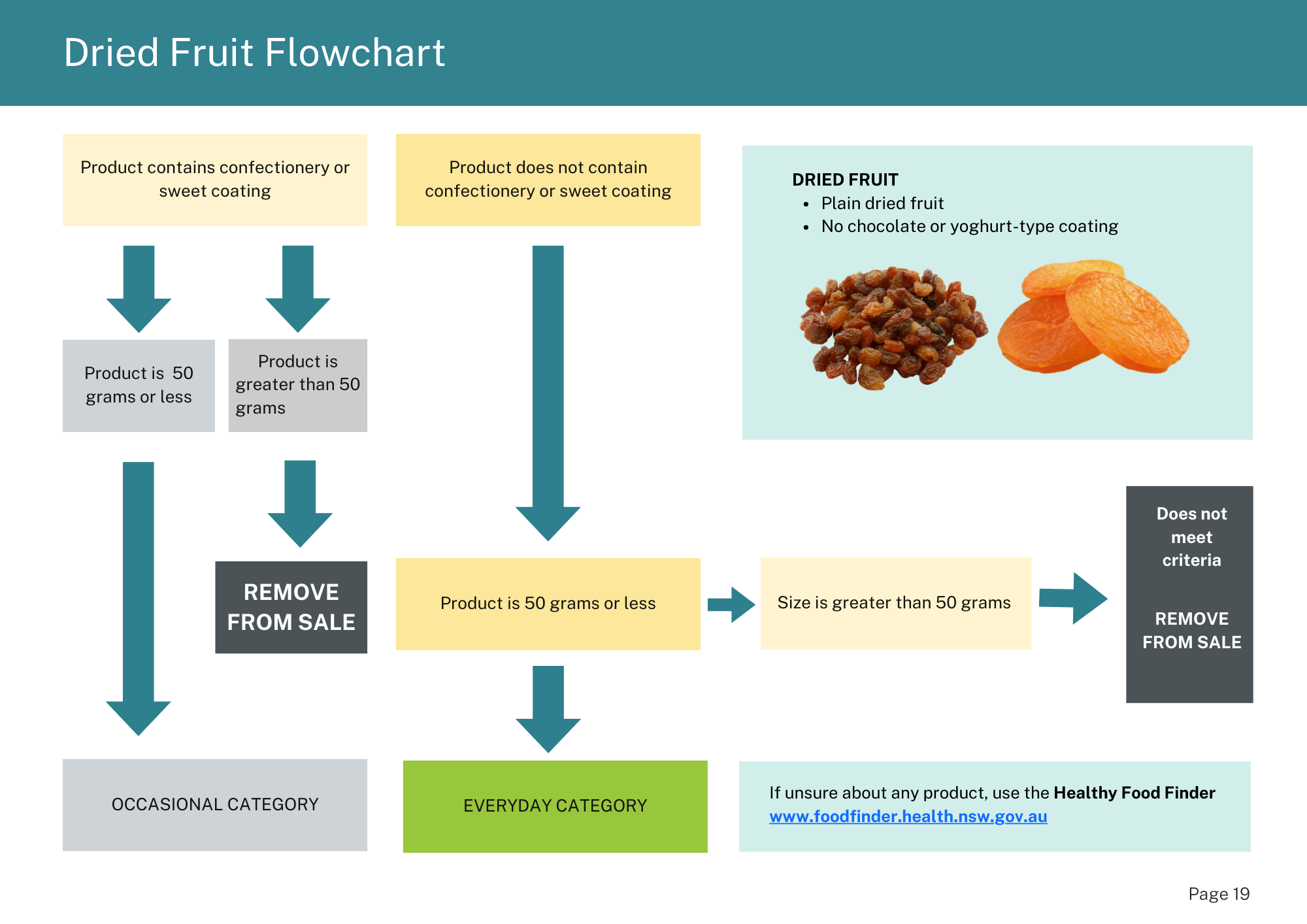
Unsalted snacks
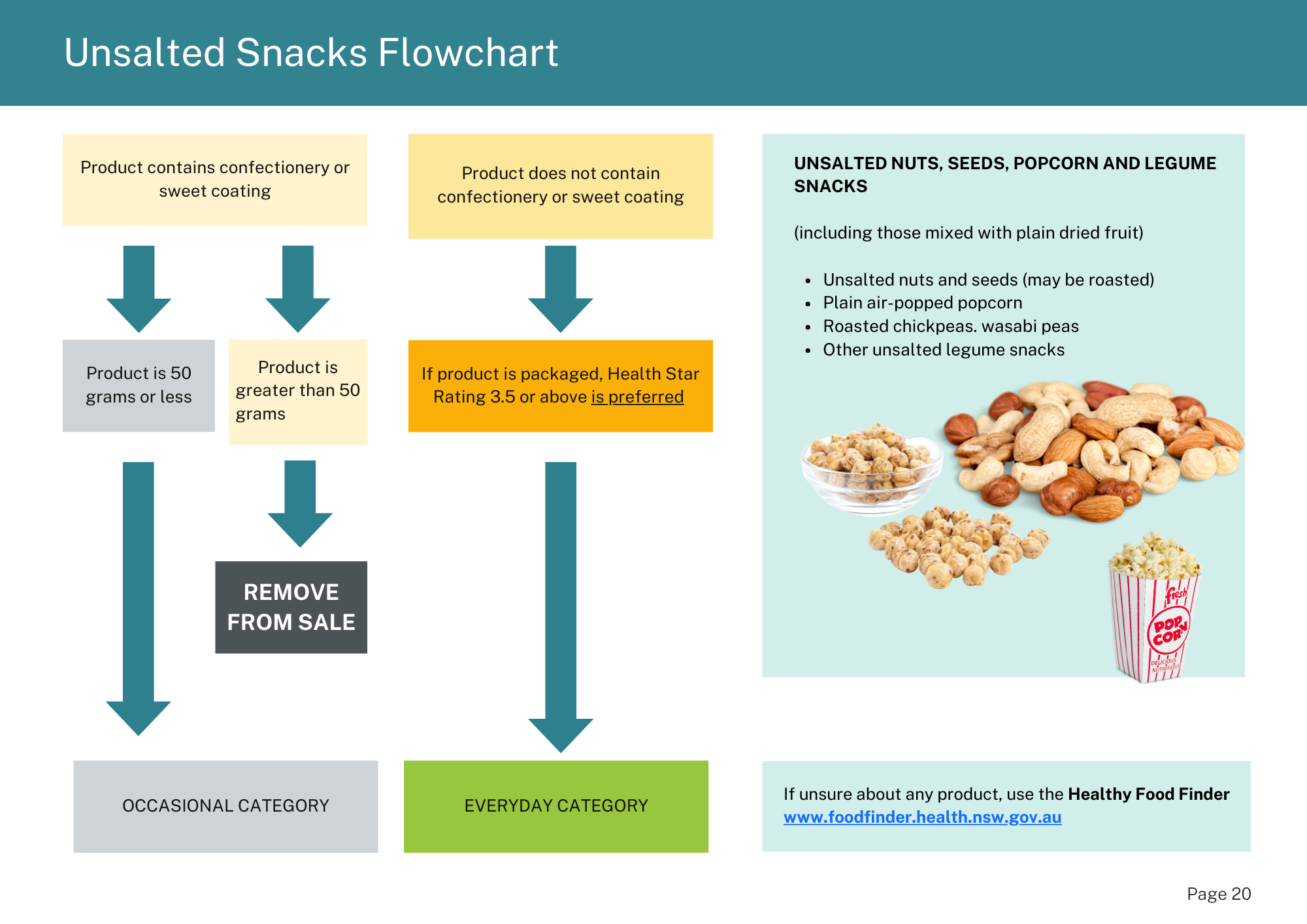
Lightly salted snacks
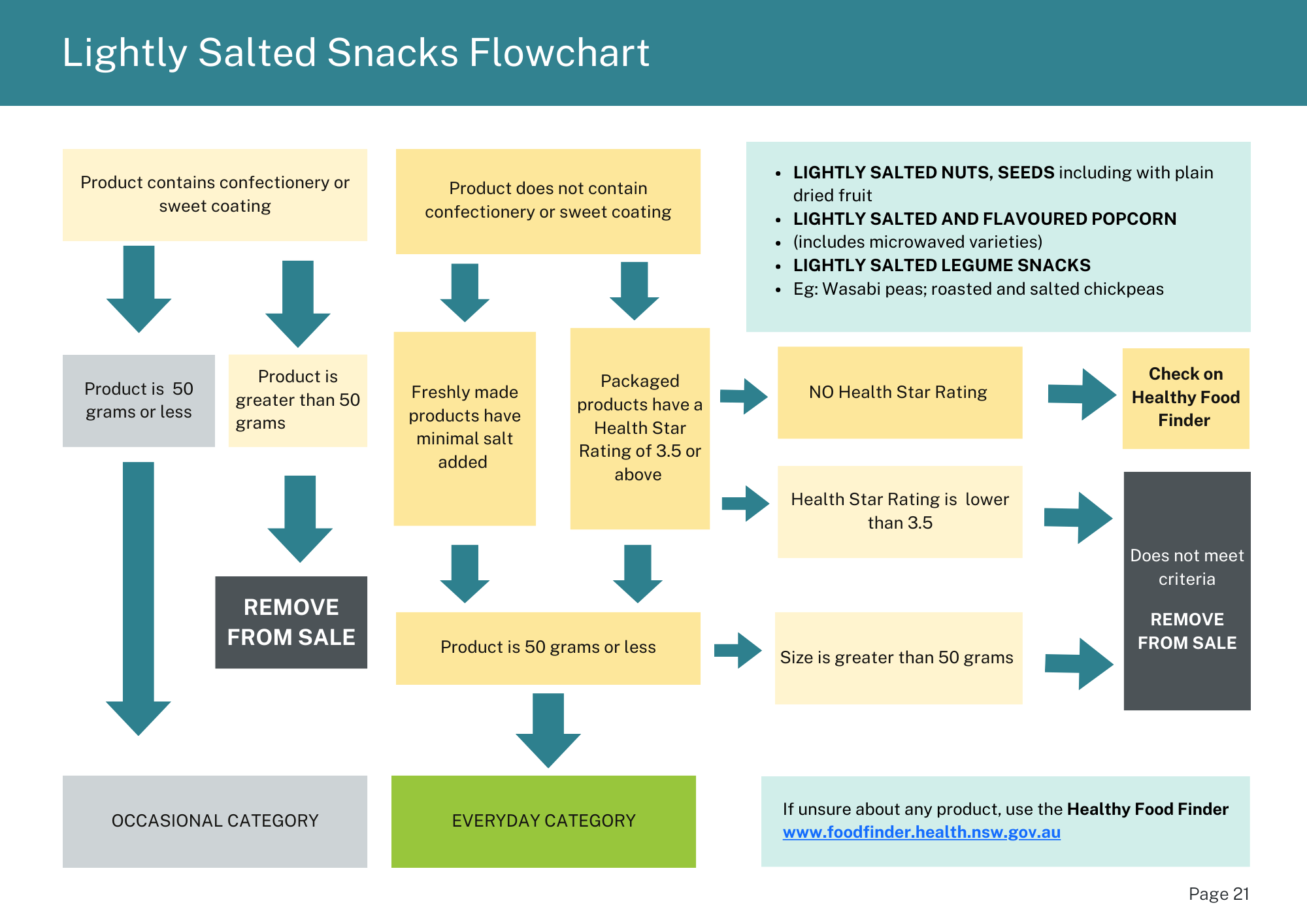
Salty snacks
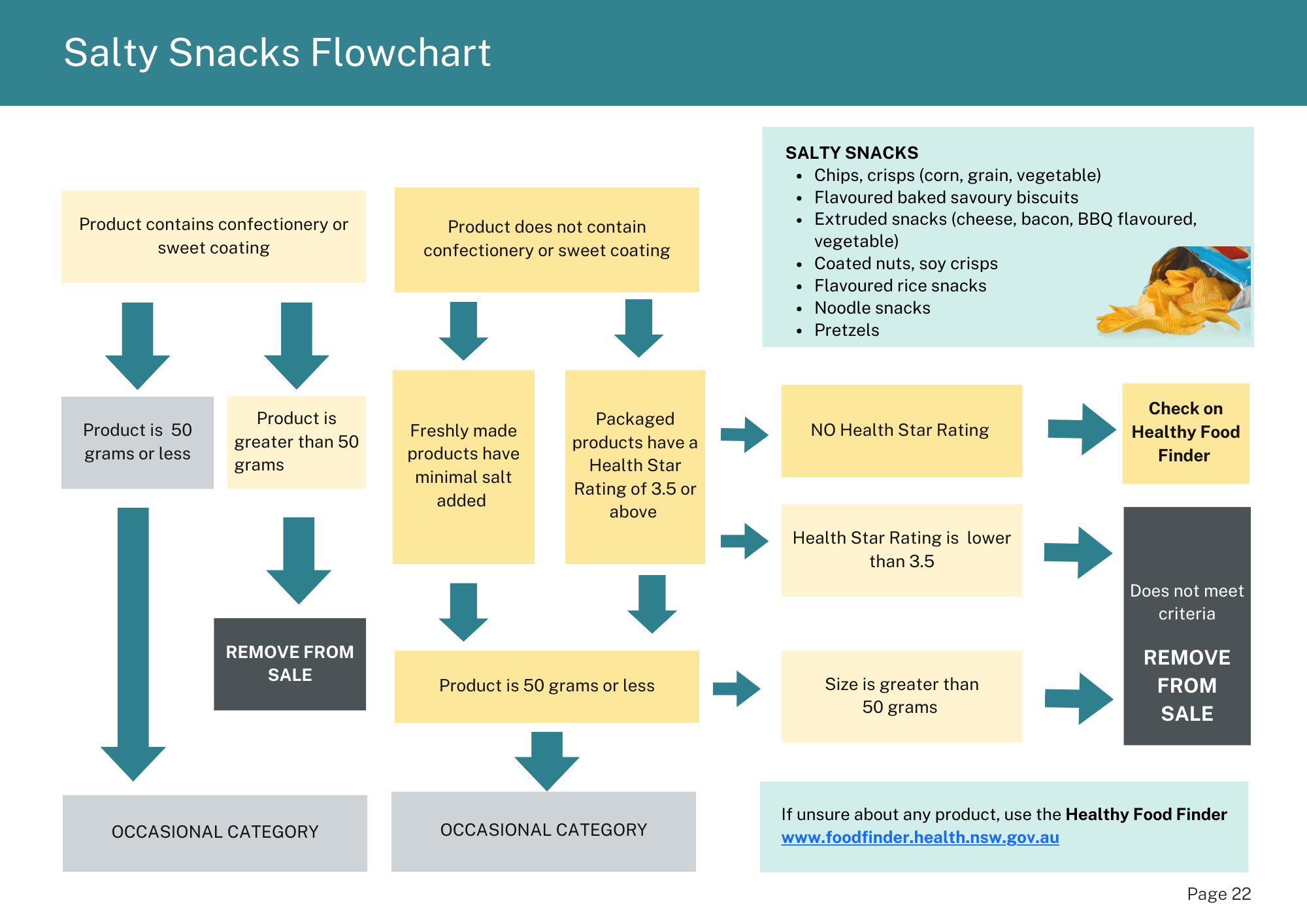
Confectionery
All confectionery is OCCASIONAL. To meet criteria confectionery must meet portion limits.
- All confectionery has a portion limit of 50g
- Includes both pre-packaged and pick-n-mix
- Includes both single serve and multi-packs.
Confectionery includes:
- Chocolate
- Lollies
- Cough lollies, eucalyptus drops and other medicated sweets
- Chewing gum
- Jellies and gummies
- Toffee and caramels
- Liquorice
- Marshmallows
- Carob confectionery
- Yoghurt-type confectionery
- Diet, low-sugar and sugar-free confectionery
- Sprinkles, 100s and 1000s, candy chips
- Everyday products that contain confectionery (e.g. muesli bars with choc-chips or yoghurt-style coating; fruit and nut mix with choc chips).
Confectionery does not include cocoa, cocoa nibs and cocoa dusting or gift boxes.
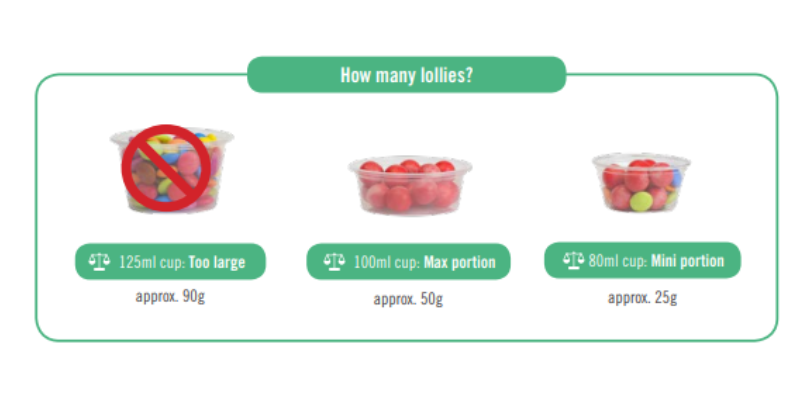
Cakes, muffins, biscuits and sweet pastries
Everyday options
- Plain scones
- Fruit scones
- Vegetable scones
- Plain pikelets
- Plain pancakes
- Fruit pancakes.
May be served with:
- Fruit
- Spreads - small amount or portion packs
- Maple or golden syrup (1 tablespoon).
Occasional options
Maximum portion size 80g. Preferably un-iced:
- Cakes
- Sweet pastries
- Croissants
- Danishes
- Banana bread
- Slices.
Maximum portion size 50g:
- Sweet biscuits
- Breakfast biscuits.
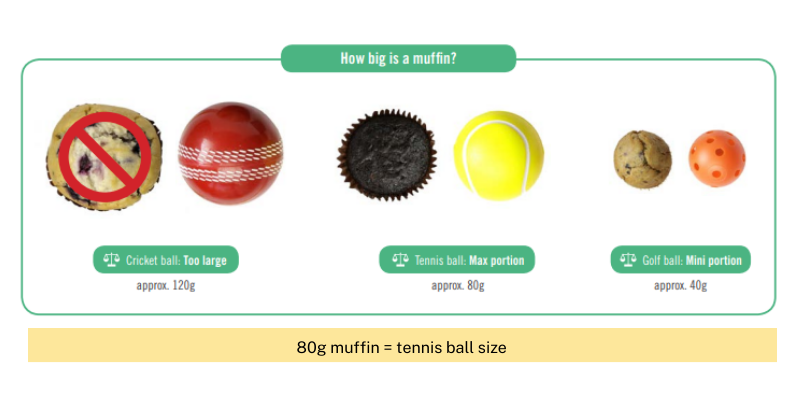
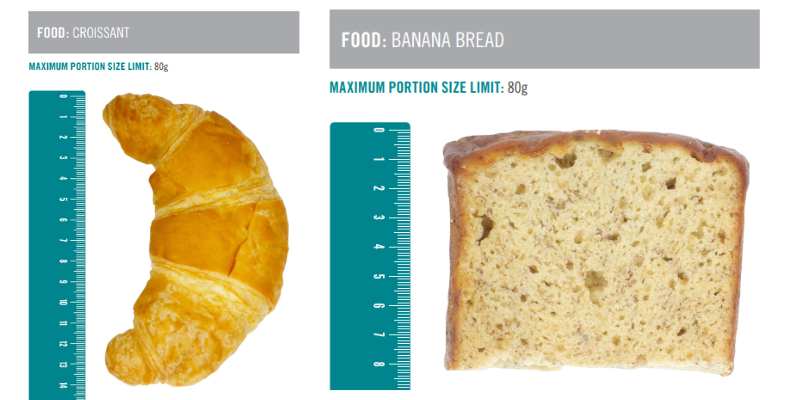
Desserts, ice-creams, frozen yoghurt, ice-blocks
All these products are OCCASIONAL. To meet criteria, they must meet portion limits.
Ice-cream, frozen yoghurt and ice-blocks
- Individually packaged or scooped on site.
- Maximum portion size 85ml.
Desserts
- Mousse
- Cheesecake
- Puddings
- Rice pudding
- Coconut-milk-based yoghurt
- Maximum portion size 100g.
Eye level
Products at eye level must be EVERYDAY products.
Eye level definition: Shelves or counter tops level with the eyes of an adult.
This is usually:
- The second or third shelf from the top.
- Or 1.3 - 1.5 metres from the floor.
This applies to:
- Vending machines
- Ambient shelving (at room temperature)
- Counter tops at eye-level
- Free standing shelves
- Shelves on a wall.
Does not apply to:
- Shelves inside chilled, hot or ambient food or drink displays.
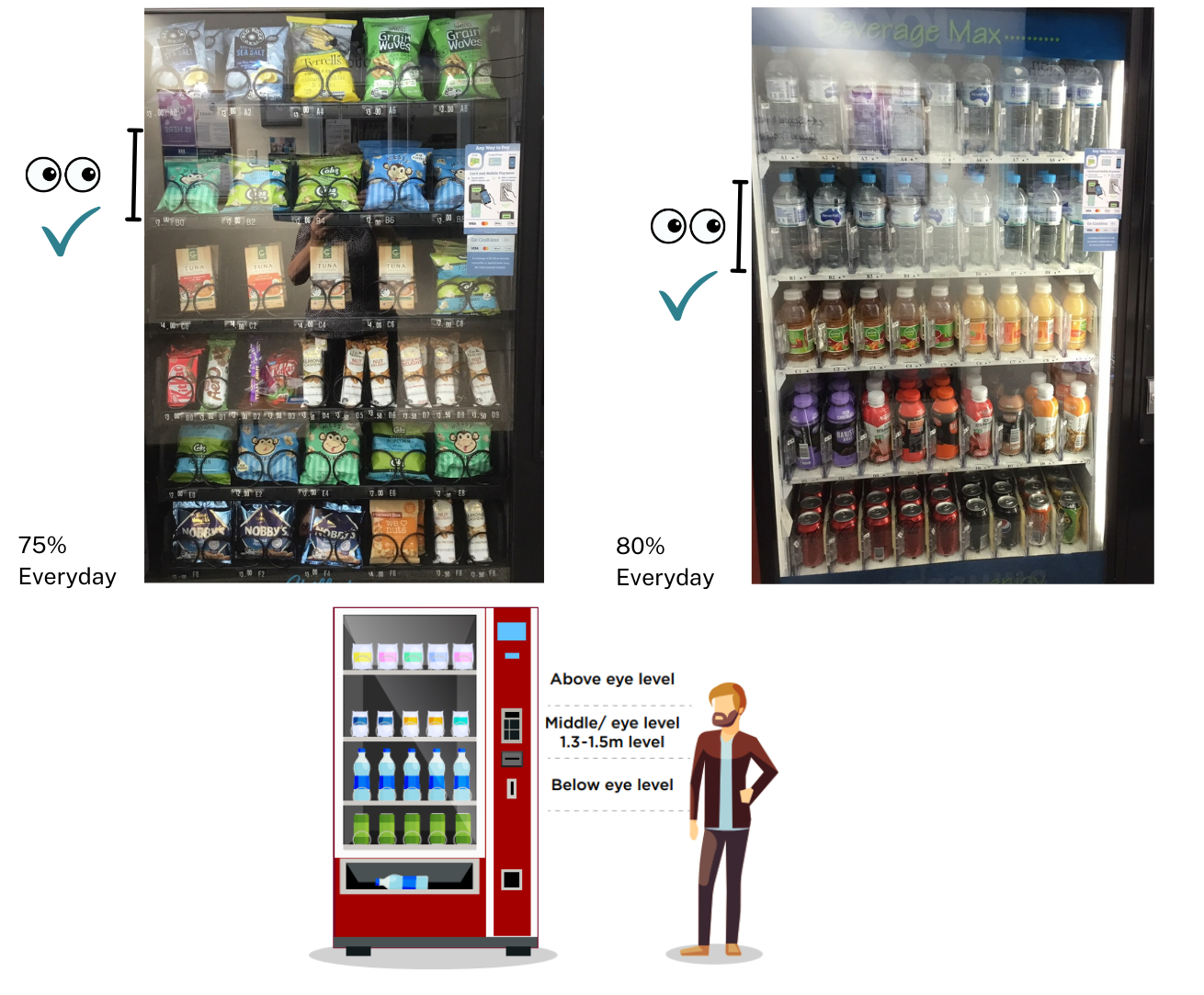
Till area
Products within arms reach of till area must be EVERYDAY products.
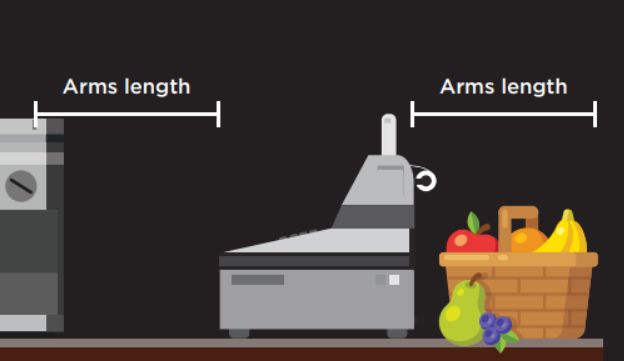
Advertising, promotions and package deals
- Advertising of EVERYDAY products only.
- Packages and promotions must contain only EVERYDAY foods and drinks.






